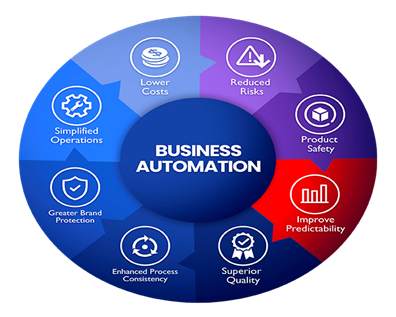In this article we will give you more informations about: what is Business Process Automation theire advantages and applications, so let’s have a look together:
Today’s business landscape is a whirlwind of change. Great products and services are just the table stakes, businesses need to be nimble, efficient and adaptable to thrive. This is where Business Process Automation emerges as an unstoppable trend.
This groundbreaking technology empowers businesses to streamlines operations, enhance efficiency and slash costs. But what is Business Process Automation, and how can it transform your company?
Understanding BPA (Business Process Automation):
BPA is the strategic use of technology to streamline repetitive tasks and workflows, freeing up valuable time resources, reducing errors and empowering your business to operate more efficiently. Imagine automate tasks like data entry, document management, customer onboarding, or even order processing. To achieve this, BPA leverages technology and software solutions like software robots (RPA), automated workflows and business process management (BPM) systems, facilitating intelligent and efficient automation across your operations.
The building block of workflow automation
Workflow automation (BPA) relies on several key components to function effectively:
- Workflow Management: This cornerstone dictates the sequence of steps needed to complete a process, ensuring efficient and accurate execution.
- Seamless Integration: BPA often bridges different software applications and systems, fostering smooth data flow and communication within the organization.
- Automated Decision making: Predefined rules and conditions enable systems to make decisions and take actions independently, freeing up human resources.
- Data automation: Automation solution tools capture, extract and process data from various sources, minimizing manual data entry and reducing errors.
- Performance insight: Analytic and reporting features within automation platforms offer valuable insights into process performance, allowing for continuous improvement and optimization.
Advantages of BPA
The adoption of automation solution offers many benefits to organization of all sizes:
Minimized errors: Automation reduces the risk of human error associated with manual tasks, including data entry and processing, leading to higher accuracy, improved quality of work and ultimately, significantly enhanced operational profitability.
Increased efficiency: BPA also enhances the visibility and traceability of operations, which facilities informed decision-making.
Free up time: By automating repetitive and time-consuming tasks, streamlining operations empowers organization to accomplish more in less time. This not only leads to increased productivity and throughput but also frees up valuable time for employees. This allows them to shift their focus to more strategic and value-added tasks, ultimately enhancing overall operational efficiency and employee satisfaction.
Building customer loyalty: Faster responses, few errors and smoother processes are the key to customer satisfaction.
Business Process Automation applications
BPA can be applied to a wide range of areas within a company, transforming its operations for greater agility and market competitiveness.
In manufacturing, it manages supply chains and logistics through automated workflow management tools.
Also in human resources, it automates administrative tasks related to recruitment, training and performance management.
but In financial operations, it automates accounting, reporting and invoice management through advanced software solutions.
In short groundbreaking technology can be applied to all functions of a company.
Unlock new possibilities with business automation to accelerate growth and drive innovation
Workflow automation (BPA) has the potential to radically transform businesses. By reducing costs and improving efficiency, it allows companies to increase their market competitiveness.
Additionally, it fosters innovation by freeing up human resources from routine tasks and allowing them to focus on higher value-added activities. Moreover, Business Process Automation promotes a culture of continuous improvement by identifying bottlenecks and optimizing operations for overall better performance.
Curious how industry leaders are leveraging BPA to gain a competitive edge? Look no further! We will explore how companies are optimizing their workflows, maximizing efficiency and driving results through the power of groundbreaking technology.
Here are a few inspiring examples;
Amazon; integrate Business Process Automation across its operations. From order processing and shipment tracking, to inventory management and customer service. And this plays a key role in Amazon’s proficiency.
Tesla; at Tesla’s manufacturing facilities, automation solution play a crucial role in improving production. From automating assembly line operations to conducting quality control inspections.
Netflix; Netflix personalize content recommendations for users based on viewing history and preferences using streamlining operations. Automation goes beyond recommendations, ensuring a smooth viewing experience by streamlining content delivery and streaming processes. This clarifies the use of automation in a sequential manner.

Business Process Automation is much more than just a business trend. It is a technology that transforms businesses by optimizing operations, improving efficiency and reducing costs. Whether in order management, human resources or financial operations, BPA offers significant benefits to all functions or businesses. So, get ready to transform your business BPA and make lasting improvements to your business operations.
If you want to edit, merge or convert PDF files, you can use our free apps by clicking on this line.
If you want to know more about PDFs please read this Article.
else you can see this article on Wikipedia related to What is Business Process Automation.
